This blog isn’t just about ghostsigns, architecture, and quirky tales of local history. It’s about an experience of the whole city – including the areas that might not be thought of as attractive for a recreational walk. The most unprepossessing parts of town can be as intriguing as any other. With this in mind we walked through the Port Melbourne industrial zone and headed towards the Westgate Bridge.
First, though, we said farewell to historic Port Melbourne by walking out onto the old Princes Pier. This pier and the gate house have recently been restored and reopened to the public, and in the process of renovation a series of timber posts, that supported the original pier, have been revealed. They are now visible, several hundred stumps rising from the waves, like a piece of modern landscape art.

The waterfront along Beach Street has been developed in recent years and is crowded with crap generic apartment blocks of the kind you see along the waterfront of pretty much any coastal city in the world.

More interesting are the two white light houses at either end of Beacon Vista. Built in 1924, they served as navigation aids for ships steering their way into the bay, and are still in use today.
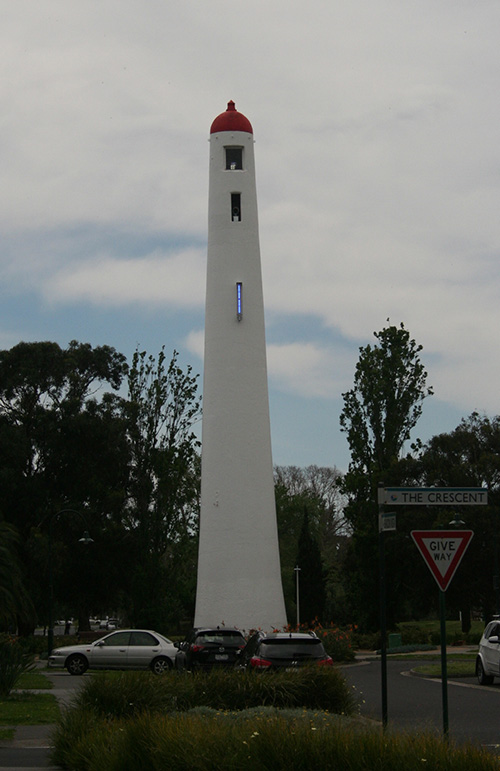
Nearby, under the Graham Street overpass, is a gallery of street art which we stopped and admired for a while.


We walked up to Williamstown Road, turned left, and headed west. On the corner of Salmon Street we spotted a building with 1930s deco stylings, now a self storage place. Self storage is one of the stranger growth industries of our times. We now have so much stuff in the developed world that we have outsourced looking after it to warehouses in places like Port Melbourne industrial estate. We work long hours and earn money to buy stuff to put in boxes and then pay someone to take care of it for us. I have often thought that there is a good novel to be written or documentary to be made about the goings-on of a self-storage facility.

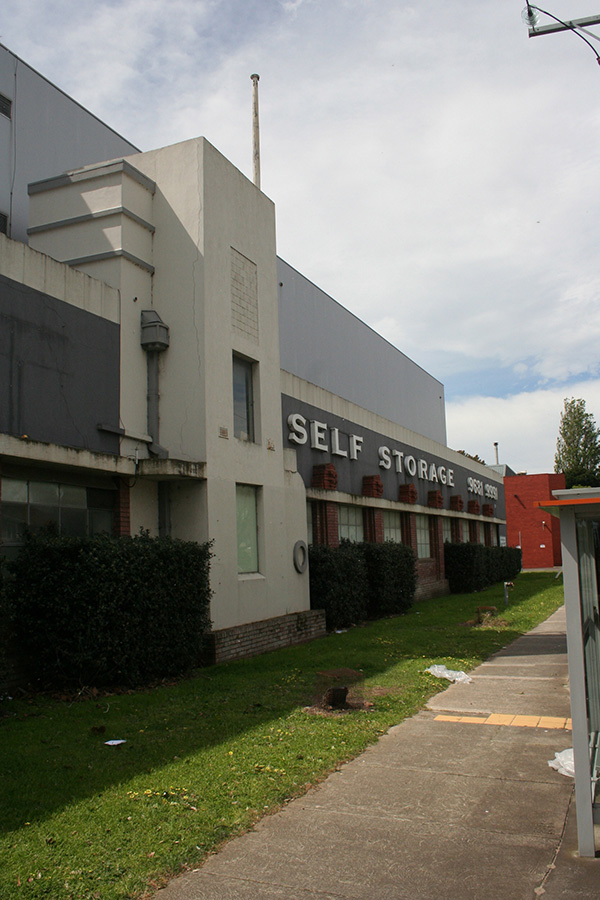
The former BALM paint factory on Williamstown Road.
Now we were deep inside the dark heart of the industrial estate. It was Saturday, and the place was deserted like a post-apocalyptic landscape: empty car parks, vacant streets, no sign of life except for a few people heading in to the go-karting place ($1 a lap, minimum 40 laps). Many of the buildings were low, flat warehouses with no distinguishing features, with some more interesting interwar architecture interspersed. Quite a few of the businesses are recreational rather than industrial: go-karts, paintball, and something called an ‘escape room experience’ which offers you the thrill of being trapped in a room with 45 minutes to escape.
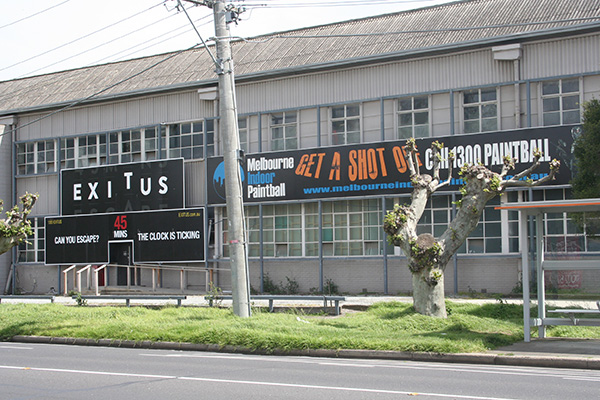

Industrial architecture, Salmon Street.


Industrial architecture on Salmon Street.
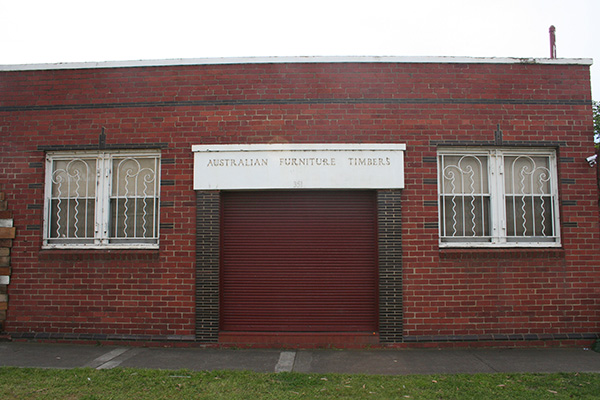
Some unexpected ornamentation on these windows.
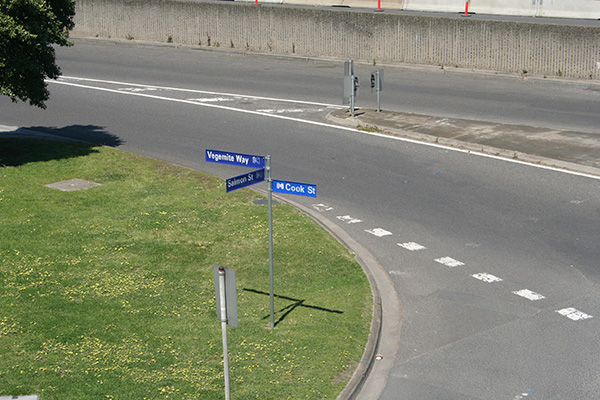
Vegemite and salmon – Port Melbourne intersection.
Some ghostsigns are visible on the wall of a former servo, also on the Salmon Street/Williamstown Road corner.
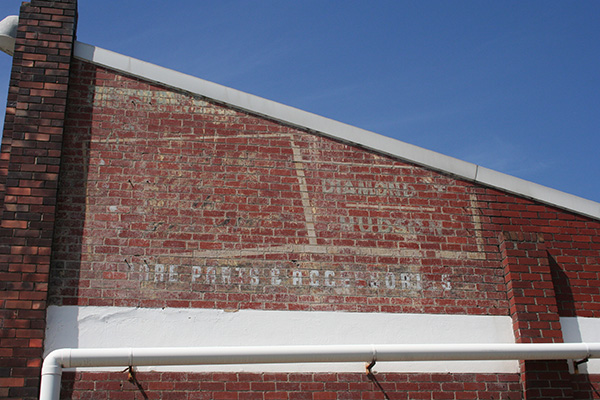

Otherwise it’s a landscape of self-storage, couriers, logistics and financial services, and businesses whose activities are impossible to identify. It’s designed to be as boring as possible, so your eye glides over it.

But as we turned a corner into Prohasky Street, thousands of containers came into sight, arranged like a painting by Mondrian.

It was a hot, windy day, and blizzards of pollen were blowing down the empty streets like snow. At the end of the street we turned left and started walking along beside the Westgate Freeway. On our left was a container yard, along with an open drain full of garbage. There was no footpath so we walked along a rocky grass verge between the road and the drain. It was safe to say that pedestrianism was not encouraged but there was no other way.
“These are the edgelands,” I said, “the parts of the city that no one occupies, that no one cares for, that no one thinks about.”
“The edgelands don’t like us,” Lynne responded.”And there are probably snakes.”
“But you are getting a different view of the city,” I mansplained. “Isn’t it exciting to be seeing Melbourne in a way that most people don’t? You would normally have to break down to have this experience.”

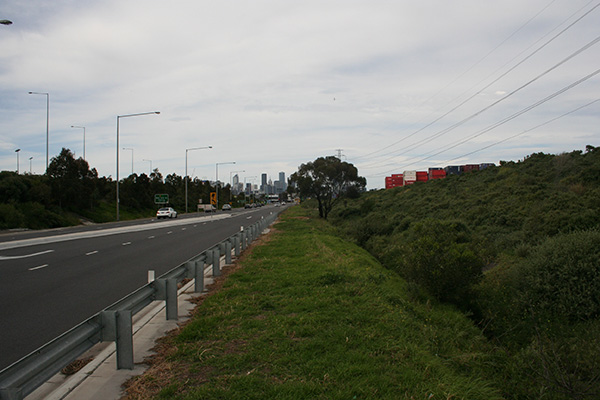
Lynne told me how she once got a puncture when riding her bike in the outskirts of a French town, and had unwisely accepted a lift back to town from a creepy guy sitting creepily in his car who could have been a psychopath but turned out to be only a pimp sitting there supervising his girls. The moral of the story was that she doesn’t like edgelands because they are outside the regulated, observed and public world: all kinds of things go on there and no one notices because they are, well, edgelands. They are places that you drive through, or past, on the way to somewhere else. Maybe everyone has unsettling memories of edgelands, which is why we avoid them.
By now we had reached Todd Road, the point at which traffic either comes off or enters the Westgate Freeway before crossing the West Gate Bridge. I wrote about the other side of the bridge a couple of years ago, when I had just started this walk, so meeting it from the other side felt like reconnecting with an old friend. There is a footpath and bike path under the bridge, leading to Westgate Park, so Lynne was reassured that we were now back in the civilised and regulated world. We crossed obediently at the lights and headed into the park.
I had driven over this park many thousands of times, but never set foot in it before. This is one of Melbourne’s newest parks and, information boards told us, unusual in that it had been created in the early years of the 21st century by a friends’ group who reclaimed the area and revegetated it with native species. It contains two lakes – one salt water, one fresh water. At certain times of the year the salt lake turns pink, due apparently to algae. However, it is presently a more orthodox colour.


The park attracts many native birds, none of which I know the names of. Obviously, I can’t recognise any native plants either. Robert MacFarlane, the English nature writer who writes so beautifully about how nature is reclaiming urban and industrial spaces, would be able to say something like “I heard the plaintive cry of the lemon-footed shrike” but all I could say was things like “Oh, look at that white one.” Suddenly, from the unidentified native bushland at our feet, something whirred into life and zoomed up into the air: I looked up in the hope of seeing a rare native bird, but it turned out to be a guy playing with a drone.
So we walked around the lakes, through bushland which is undeniably pleasant, while the traffic whomped over the bridge above us. Millions of winged insects – dragonflies, Lynne said – zoomed around us in a way that was frankly annoying. There are sculptures in the park, big wooden totemic things, a bit reminiscent of the wooden posts we had seen earlier in the ocean.
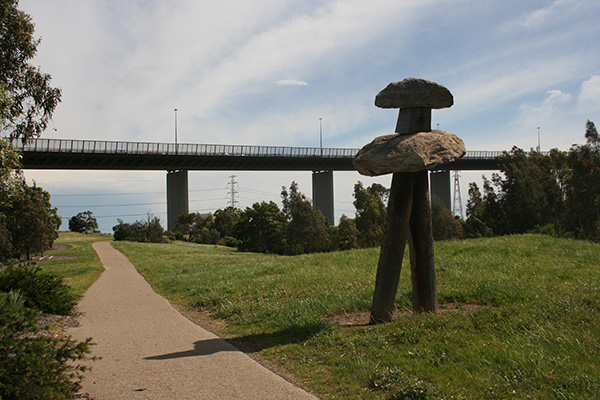
Sculpture by Lyn Moore in Westgate Park. West Gate Bridge in the background.

More sculptures by Lyn Moore.
“Look!” Lynne said, “a blue wren.” And there was a small bird with blue flashes on its wings. It was great to see something that we wouldn’t normally see, all the more so for it being in such a location, under a freeway not far from the docks. And although I don’t know any of the names of the native flora and fauna, it feels good to know that it is there.
*
More on the park: ‘Journey to the pink lake’ by Carringtonia on her blog Rising to Gale.
Find out more about Westgate Park at westgatepark.org.
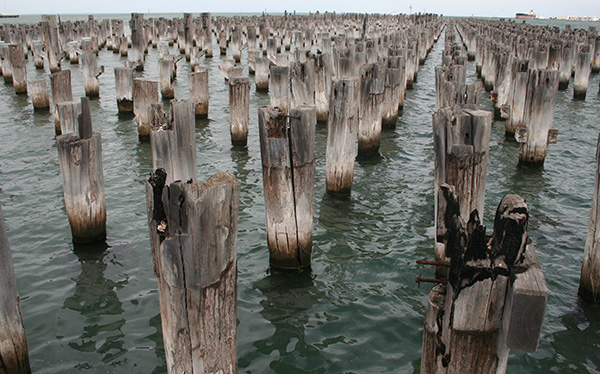









“There’s nothing to look at”? How could there be nothing to look at? There’s always something – and those big red containers! Containing, possibly the things that people buy and then, after a few months, put them into self-storage.
True, Vin. Perhaps it would be simpler if the containers were simply moved directly to self storage in the first place.
So true about self-storage. I used to have stuff in self-storage for a few years whilst I lived in a small apartment in Brunswick (before moving back to a conventional house). I got to know the management people and it is quite an experience inside the maze of shuttered “storage units”. there must be some great stories there – reality TV has already taken it on with those guys in US who buy up old storage units.
Thanks Dana!
Every single time I see a self-storage complex I am reminded of the wonderful “Head in a Jar… in a Car” scene in Silence of the Lambs by Thomas Harris. Puts me right off storing anything there.
I don’t recall the scene but not surprised that Thomas Harris would see the horrific possibilities of storage.
In Canada, the style of sculpture seen in Westgate Park would probably be called Inuksuk (https://en.wikipedia.org/wiki/Inuksuk). Love ’em!
Fascinating! Yeah, there are quite a few of these around the park, by artist Lyn Moore. Thanks.
Excellent witty post about these edgelands!
Thanks Imogen!
Hi Nick The industrial area around Salmon Street is a treasure trove of interwar buildings. You mentioned Securway – this is an extract from a walk booklet of Port Melbourne/Fishermen’s Benbd that i am currently updating. 19. SECURWAY STORAGE, Cnr. Salmon Street and Williamstown Road.
One of the factories constructed in Fishermen’s bend to service local manufacturers was built in 1937 for paint manufacturers BALM (British Australian Lead Manufacturers Pty Ltd), and associated companies such as United Paint Company and Red Lead Manufacturers. The factory manufactured paints and varnishes including ‘Dulux’ and ‘Duco’ lacquers. It represented part of Port Melbourne’s industrial heritage of the interwar period and demonstrates its manufacturing capacity. In 1955 the company changed its name, becoming BALM Paints Pty Ltd.
The building is described in the Port Phillip Heritage Review as a ‘single-storeyed factory with administrative section in front in the European Modernist manner’. The emphasis is on the horizontal and the conventional hip-roofed factory rectilinear factory complex was enlivened along its Williamstown Rd. frontage by canted brick piers that projected through a continuous concrete sun hood, and a fluted parapet. A distinctive feature is the squat rendered tower that featured an off-centre flagpole rising from a telegraphic plinth. A distinctive feature is the brickwork between the windows, which extends vertically through the cement window hood. The designer was architect and engineer W. J. (Will) Grassick, who was responsible for designing a number of factories in industrial suburbs, including the Ford Motor Company at Geelong. (1925).
BALM relocated in 1973 and the buildings were occupied by the CSIRO (Division of Mineral Chemistry) (check sands and Mac). It has now been converted to a storage facility and is operated by Securway Storage.
It is covered by Heritage Overlay HO282 within the Port Phillip Planning Scheme.
Great stuff, thank you Robin. The Securway place is a lovely building, I had wondered what its original purpose was. The building that is now the car place/paintball venue looks like an interesting interwar building too. I will have to get back to Salmon Street and explore again with your booklet when it is available. Cheers, Nick
My uncle worked in the BALM Paints building; not in the factory but the office. A wonderful building. Sometimes on a weekend we took the Newport punt at the end of North Road across the river and rode our bikes down Williamstown road past Fisherman Bend to Port Melbourne. Runways surrounded the buildings of the Commonwealth Aircraft Corporation and General Motors Holden at Fishermans Bend. Great blog.
Thanks for sharing those memories.
Adding to Robin’s comments about the BALM Paint Factory, people may be interested in its use by the CSIRO Minerals Division to the late 1980s.
http://www.pmhps.org.au/2013/08/the-csiro-in-port-melbourne/
Think of Salmon Street as a centre of car manufacturing in the post-war period, Charles Daniel Pratt’s aerial photos at the SLV give the best appreciation of the disposition of the car factories (Rootes and GMH) and their relationship to the Garden City and Fishermans Bend estates on the other side of Williamstown Road.
Fishermans Bend is on the brink of a massive change – transformational change like that which led to the development of industry in the post war period – but on a huger scale.
To give some idea of the land values – the site at 18-22 Salmon St behind the storage facility was reported in Saturday’s Age as likely to sell for $30m.
Fascinating, thank you for that information Janet.
Very interesting and enjoyable post! The Robert MacFarlane bit made me laugh – with you and know exactly what you mean. Wish I could identify birds and plants instead of saying “there’s a er bird, and here are um plant things”. Still – he’s a great writer, partly because he knows all those evocative names.
Thanks Alex! Yes I love MacFarlane’s work but all that knowledge of ornithology and geology just reminds me how little I know.
Thanks for the mention, Nick – reading this brought back happy memories of Port Melbourne, one of my favourite Melbourne places. I was very interested to see the photos of the lake in its not-pink state.